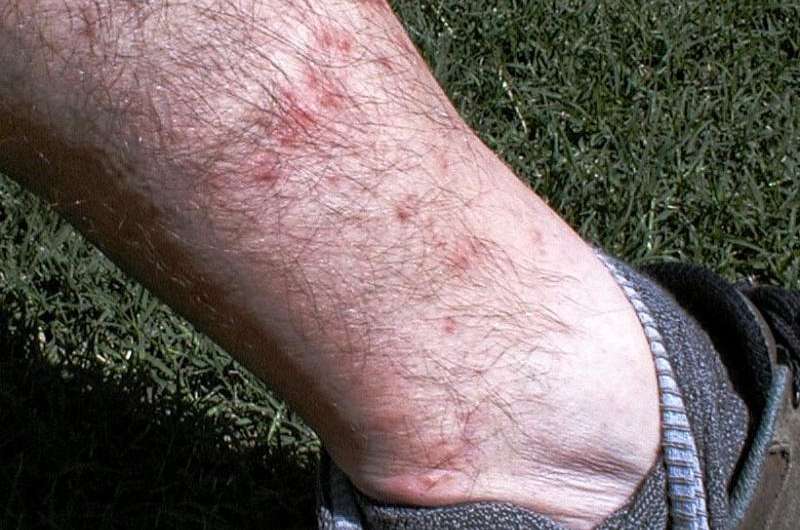Chiggers, fleas more noticeable in summer

As people become more active in summer, so do a few familiar pests that keep Texans itching – and scratching for relief, said Texas A&M AgriLife Extension Service entomologists.
"This time of year there's usually a significant increase in chigger and flea activity," said Wizzie Brown, AgriLife Extension entomologist, Travis County. "With people and their pets spending more time outdoors, the likelihood of getting bitten by chiggers or fleas also increases."
Brown explained chiggers are mites in the immature stage.
Molly Keck, AgriLife Extension entomologist, Bexar County, said chiggers develop in fields and weedy areas, especially areas with tall grasses.
"While chiggers are active from spring through fall, they are most noticeable in the summer, especially early summer when there's a good amount of vegetation," Keck said. "The larvae gather on the tips of plants and other locations where they crawl onto hosts."
She said chiggers typically live in edge habitats or zones – areas of denser vegetation next to areas more open or lacking in vegetation.
"This might be a thick garden along a fence line next to a well-manicured lawn or in the tall grass that borders a walking trail," she said. "These are good locations to avoid."
Brown said chiggers climb onto people walking through infested areas, crawl upwards and wander around the body seeking a good site to settle down and feed. The preferred feeding locations are areas where skin is thinnest or where clothing fits tightly, such as around the ankles or waist or behind the knees.
Brown said when chiggers feed, they inject a digestive enzyme that breaks down skin cells, which are then eaten.
"Itching and redness are caused by our body reacting to the enzymes injected into our skin," she said. "It typically begins three to six hours after being bitten, peaks at 24 hours and can last up to two weeks."
She said the best way to avoid chiggers is to keep away from areas likely to be infested, but if that is not possible, some other ways to protect from them include:
- Wearing protective clothing such as tightly woven items that fit loosely, including long sleeves and pants. Do not go barefoot or wear sandals or open-toed shoes.
- Use an insect repellent with DEET or picaridin.
- If wearing boots, tuck the pant legs into them.
- Avoid sitting on the ground.
- Remove and launder clothing as soon as possible after being in infested areas.
- Shower or bathe soon after being in an infested area. Scrub vigorously with a washcloth.
She said some ways to reduce the possibility of chigger infestations around the home include
keeping the lawn mowed, not allowing weeds to grow, keeping brush cleared and targeted use of residual pesticide sprays.

"Sprays with pyrethroids have proven to be effective," Brown said. "But if you do get bitten, avoid scratching any pustules caused by the bite as opening them may lead to infection. Use oral antihistamines or topical anti-itch creams to relieve the discomfort."
Fleas too are pests that reappear persistently during summertime, the entomologists said.
"Fleas are small, wingless insects with flattened bodies and all body spines pointed to the rear for easier movement through the fur or hair of an animal," Keck said. "Their mouthparts are formed for piercing and sucking."
Flea larvae are found in the nests of various animals, in rugs or carpets in the home or in the soil in areas where animals frequent. They feed on organic debris and as adults are blood-feeders.
"Fleas are ectoparasites and females require a blood meal to produce eggs," Brown said. "After feeding on a host, females can produce about 30-50 eggs per day that fall off the host animal and into carpeting or other areas inside and outside the home. After fleas pupate, they hatch out of the cocoon in about two weeks, but pupae can remain dormant for up to five months."
She said proper flea management has multiple parts.
"Fleas should be managed on the pets as well as in the environment," she said. "Grooming the animal with a flea comb and/or bathing it regularly can help reduce flea numbers. Wash pet bedding in hot water and avoid walking pets in known flea-infested areas."
Brown said a veterinarian should be consulted about flea control products for pets.
"There are numerous products on the market that work well when used according to label instructions," she said. "When you find fleas on a pet, you need to not only treat the pet but also any areas the pet frequents—both inside and outside the home."
Brown noted fleas found around or in homes without pets may be coming from wildlife.
"Attic and crawl spaces should be inspected for wildlife activity," she said. "Wildlife should be removed, and after removal the area should be treated with an insecticide labeled for fleas. Then the area should be sealed so wildlife cannot re-enter."
Brown also advised that new homeowners may have problems with fleas shortly after moving in if the previous owners had pets with fleas.
"You should vacuum thoroughly and regularly under furniture and along baseboards to reduce flea eggs, larvae and pupae. Then place the used vacuum bag in a sealed plastic bag and throw it into an outdoor garbage can so fleas do not hatch out and re-infest the home."
She said outdoor flea treatments targeted to areas where pets frequent should be done at least twice.
"The second treatment should occur 10-14 days after the initial treatment," she noted.
Provided by Texas A&M University
















